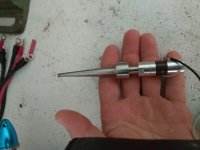okashira
10 kW
Are you going to be using it long term? How is it working out?

No, but the first images in thisENNOID said:Does anyone here has any experience with ultrasonic transducer oscillator circuit/power supply?
we simple peasants think of to emulate their equipment it will never be on the same level as them. but with spot welding and a simple kweld you can make welds as good as dewalt puts in their battery packs.
